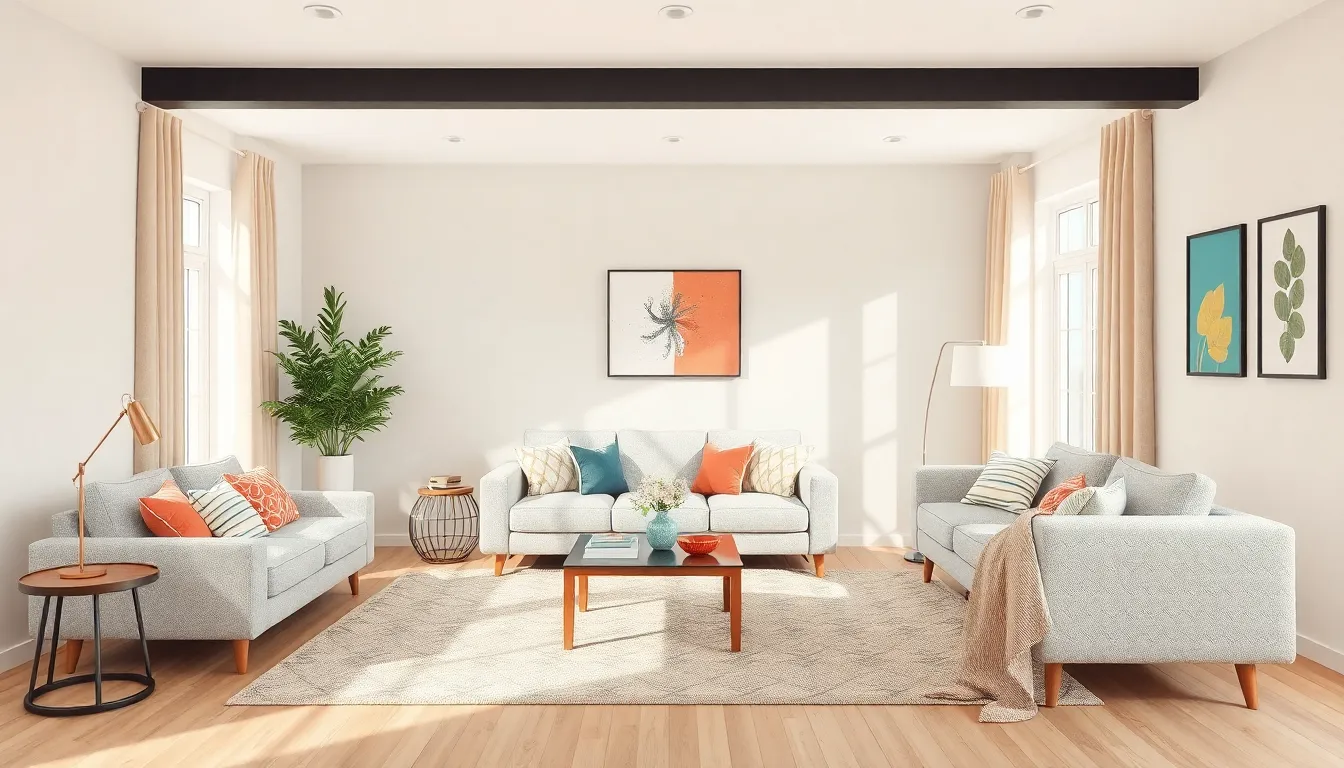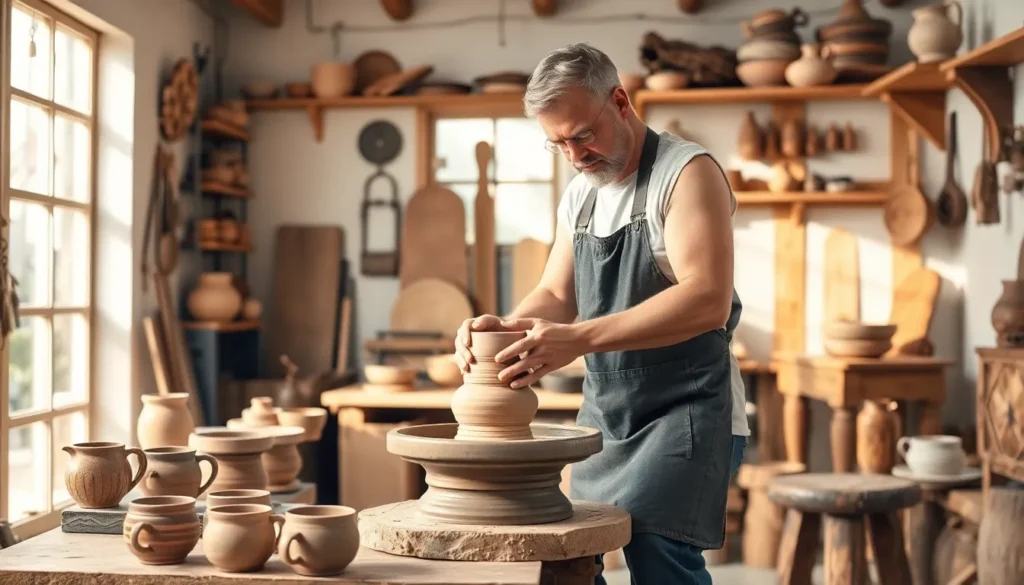When it comes to transforming a space, interior design concepts are the secret sauce that can turn a blah room into a fabulous haven. Think of it as a magic wand for your home—wave it around, and suddenly your living room goes from “meh” to “wow!” With endless styles and innovative ideas, anyone can become a design wizard, even if their last DIY project ended in a paint disaster.
Table of Contents
ToggleOverview of Interior Design Concepts
Interior design concepts encompass a range of styles and ideas essential for creating functional and aesthetically pleasing spaces. Balance, symmetry, and harmony often serve as the core principles guiding design choices. Various styles, such as contemporary, minimalist, and industrial, offer distinct approaches that cater to different tastes and functions.
Color theory plays a significant role in shaping mood and ambiance. Designers select palettes that evoke desired feelings, whether soothing tones for relaxation or vibrant hues for energy. Incorporating texture adds depth and interest, while materials like wood, metal, and fabric contribute to overall visual appeal.
Spatial planning is crucial in maximizing functionality. Designers assess the layout to ensure spaces flow well and serve their intended purposes. Focal points often emerge in each room, drawing the eye to specific elements like artwork or furniture arrangements.
Lighting design also influences the atmosphere. Natural and artificial light sources can dramatically alter how a space feels. Task, ambient, and accent lighting each serve unique functions, enhancing both functionality and aesthetics.
Sustainability is increasingly prominent in modern interior design. Designers prioritize eco-friendly materials and energy-efficient solutions, reflecting a growing awareness of environmental impact.
Incorporating personal touches defines a space’s character. Collecting items that resonate emotionally or reflect personal history adds uniqueness to the design. Each choice contributes to crafting an environment that resonates with its inhabitants, showcasing their individuality while adhering to broader design principles.
Key Elements of Interior Design

Interior design comprises various essential elements that contribute to a cohesive and engaging space. Understanding these elements enhances both visual appeal and functionality.
Color Schemes
Color schemes play a pivotal role in setting the mood of a room. Designers often select complementary colors to create harmony. Neutral tones may serve as a backdrop, allowing bolder accent colors to shine. Implementing color theory influences feelings; for instance, blue evokes calmness while yellow inspires energy. Using a consistent palette throughout a home unifies the overall aesthetic, providing a seamless transition between rooms.
Furniture Selection
Furniture selection greatly affects the usability and aesthetics of a space. Choosing pieces that fit the scale of the room prevents overcrowding. Opting for multifunctional furniture enhances functionality, especially in smaller areas. Classic and timeless designs tend to offer longevity in style, while contemporary options provide a fresh look. Prioritizing comfort alongside style ensures that spaces remain inviting for occupants and guests.
Popular Interior Design Styles
Interior design offers a wide array of styles, each bringing unique flair and functionality. Individuals can choose from modern, traditional, and minimalist aesthetics to create spaces tailored to their preferences.
Modern Design
Modern design emphasizes clean lines and a streamlined aesthetic. Often characterized by open spaces, this style incorporates neutral colors with bold accents. The use of natural materials like wood and stone enhances the visual interest. Designers frequently select furniture that boasts geometric shapes, offering both form and function. Popular features include large windows that allow natural light to flood interiors. Art pieces commonly act as focal points, drawing attention without overwhelming the overall design.
Traditional Design
Traditional design reflects classic elegance and timeless charm. Warm colors and rich wood tones create a welcoming atmosphere. Ornate furniture with intricate detailing and textures adds sophistication to spaces. Designers often favor symmetry, arranging elements to promote a balanced look. Accessories like rugs, drapes, and antique decor contribute to the cohesive feel. This style invites comfort and nostalgia, making it popular among those who appreciate history in design.
Minimalist Design
Minimalist design prioritizes simplicity and functionality. Clean, uncluttered spaces embody the essence of this aesthetic. Light colors and open floor plans create a sense of spaciousness. Essential furniture pieces often serve dual purposes, enhancing practicality. Designers focus on quality over quantity when selecting items, emphasizing fewer but more meaningful elements. The overall atmosphere promotes relaxation and calm, appealing to those seeking tranquility in their living environments.
The Role of Space Planning
Space planning serves as the backbone of effective interior design. Designers assess the layout to optimize functionality and aesthetics. Thoughtful arrangement of furniture and fixtures enhances flow in a room, promoting comfort and usability. By prioritizing spatial dimensions, designers ensure that spaces feel balanced and cohesive.
Maximizing available square footage creates opportunities for versatility in living areas. Design elements like pathways, furniture placement, and focal points significantly impact how individuals interact with their environment. For instance, open layouts facilitate easier movement and socialization, encouraging engagement among occupants.
Analyzing spatial relationships fosters creativity in design. Designers take into account traffic patterns, natural light sources, and ventilation to improve livability. Each factor plays a critical role; a well-planned space accommodates various activities while remaining inviting.
Using digital tools, designers create detailed layouts that visualize potential changes. These tools help in experimenting with proportions and arrangements, aiding decision-making. Displaying multiple design iterations allows clients to understand the effects of different configurations.
Incorporating ergonomics into space planning enhances comfort and accessibility. Furniture should cater to the daily needs of users, supporting their activities without hindrance. A well-planned space considers the height of tables, the reach of shelving, and the arrangement of seating areas.
Prioritizing sustainability in space planning also influences environmental impact. Eco-friendly materials and energy-efficient layouts reduce resource consumption while still maintaining style. Designers increasingly factor in these considerations, aligning their work with modern ecological consciousness.
Ultimately, effective space planning elevates an area from ordinary to extraordinary. Thoughtful design choices cultivate unique environments that reflect personal tastes and lifestyles. Balancing aesthetics and functionality remains a guiding principle for successful interior spaces.
Incorporating Personal Touches
Personal touches enhance a space’s character and create an inviting atmosphere. Artwork can express unique tastes, making walls come alive with color and emotion. Family photos add warmth, connecting individuals to cherished memories. Decorative items, like travel souvenirs or heirloom pieces, reflect personal stories and journeys.
Textiles, such as custom throw pillows or handmade quilts, introduce comfort and style, making spaces more lived-in. Incorporating personal achievements, like awards or certificates, fosters a sense of pride and accomplishment. Plants serve as natural elements, improving air quality while also personalizing a space with familiar greenery.
Choosing vibrant colors for accent walls or furniture pieces can energize a room, instantaneously infusing personality. Mixing various design styles, such as blending modern and traditional elements, highlights individual preferences and creates visual intrigue. Curating a collection of books on shelves invites unique character and serves as a conversation starter.
Lighting choices, such as decorative lamps or string lights, can set a mood that feels personal and welcoming. Customizing layouts with furniture placement ensures spaces are not only functional but also uniquely suited to individual lifestyles. Bringing in personal hobbies, such as an art corner or a reading nook, adds layers of identity and comfort.
Fostering a balance between design principles and personal elements creates harmonious environments where individuals feel at home. Engaging in interior design becomes more meaningful when it showcases the essence of those who inhabit the space. Ultimately, merging personal touches with established design concepts transforms a house into a true home.
Interior design concepts offer a powerful way to transform spaces into beautiful and functional environments. By understanding and applying principles like balance, color theory, and spatial planning, anyone can create a home that reflects their unique style and personality.
Incorporating personal touches not only enhances aesthetic appeal but also fosters a sense of belonging and comfort. As trends shift towards sustainability and eco-friendly choices, embracing these elements can lead to a more harmonious living space.
Ultimately, interior design is about more than just aesthetics; it’s about crafting an atmosphere that resonates with individual lifestyles, making every room a true reflection of who they are.









